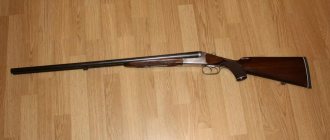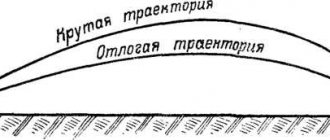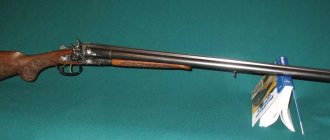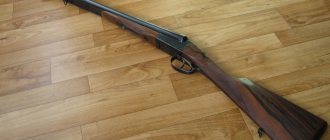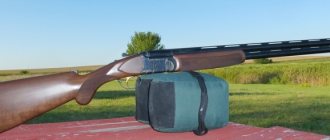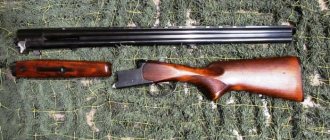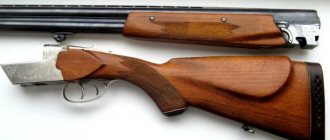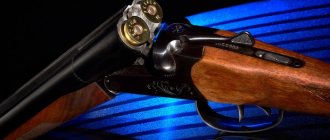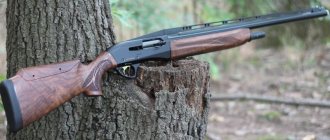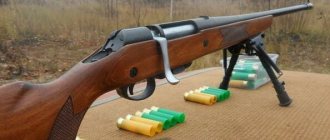The IZH-58 hunting double-barreled shotgun is an excellent example of the fact that in Soviet times they were able to make high-quality, simple, unpretentious, convenient and powerful guns. This model perfectly shows how high quality and durable the weapons produced at that time are. More than 50 years have passed, and the gun is still popular and actively used by hunters.
At the same time, the IZH-58 16-caliber shotgun is considered by many to be a living legend, which has shown its best throughout its entire existence. Unfortunately, it is now very difficult to find an IZH-58 smooth-bore hunting rifle that has retained its original performance characteristics, but sometimes you come across functional specimens that are the subject of a real pursuit.
History of creation
When developing the IZH-58 model gun, weapon designer L.I. Pugachev intended to use only 20-caliber cartridges. Before the start of serial production, an option appeared for smaller 28-caliber cartridges, which were not popular among commercial hunters.
In the series, weapons chambered for this cartridge were not produced, but were produced in single copies only upon order. As production increased, which began in 1958, new modifications began to be introduced.
This is how variants of the IZH-58 shotgun chambered for 12- and 16-gauge cartridges appeared, which became the most popular weapon options.
Modifications chambered for 20-gauge cartridges were produced under the index 58-20 until the mid-60s. The bulk of products chambered for this cartridge were produced between 1958 and 1959. Early Izhevsk Model 58 guns were exported in limited quantities. The maximum share of foreign orders did not exceed 10% of the annual output.
The first serious modernization was carried out in 1971, after which the index of the basic version of the 16-caliber changed to IZH-58M. The difference between the modernized weapon was the use of structural elements from the IZH-48 model gun.
A new version of the weapon chambered for large-caliber cartridges began to be designated 58M-12. The design used a non-automatic fuse. The modernized versions were successfully exported, and in some years up to 50% of the output went abroad.
In 1977, an automatically activated fuse was introduced into the design of the gun, which was triggered when the barrels were broken. The second innovation was an automatic ejection system for spent cartridges, which was installed on some of the products.
Weapons with such modifications began to be designated IZH-58MA and 58MAE, respectively.
Two years later, a sample of the IZH-58MA-20M shotgun was presented, created for a reinforced cartridge with a sleeve extended to 76 mm. This option was intended for export abroad, since the USSR used cartridges with a 70 mm sleeve.
All variants of IZH-58 were produced only at the Izhevsk Arms Plant. The last batches of weapons were shipped to customers in the late 80s of the last century. Numerous changes were made to the design during production.
History of weapons
IZH 58 is a classic version of a horizontal hunting weapon. High quality materials were used in production, including the unique steel alloy from the Izhevsk plant. To give the product good strength, it was processed using special equipment.
The history of IZH-58 begins in 1958. A group of engineers under the leadership of L. Pugachev began designing inexpensive hunting weapons. The main task was to minimize the costs of the new model, the basic basis of which was the well-known at that time IZH-54. The design of the existing sample was slightly simplified, and other materials were partially used. As a result, the IZH-58 weapon turned out to be more technologically advanced and structurally simpler to manufacture, which entailed a reduction in costs.
But this did not mean at all that the new model surpassed its predecessor - the quality left much to be desired. For example, previously a lot of time and financial resources were spent on the production of certain elements, but now spare parts are produced on a production line with lower quality characteristics. But the developers were able to design an affordable gun that does not require special knowledge from its owners.
Initially, the plant produced a 16-gauge version of the IZH, the barrel length of which was 73 cm. In addition, in parallel, production was launched for the 20-gauge, the length of the barrel part of which did not exceed 67.5 cm. A variant was envisaged for the 28 cartridge, but no one saw it in implementation . Further, the main IZH model was slightly modernized, the list of calibers was expanded, and since 1971 the IZH-58M has been produced in 12 and 16 gauge. The weapon block has been slightly modified. Four years later, an ejector is installed on such a sample, adding the letter “E” to the marking. 1975 was marked by further modifications of IZH, in which the letter “A” indicated the presence of a fuse operating in automatic mode.
Production of the IZH-58 was stopped in 1986, even though the gun was awarded a gold award at the Leipzig Fair. This is how its design solutions, high degree of reliability, and solid resource capabilities were noted. Over the entire period, the plant produced more than one million copies of IZH, which included various versions and modifications.
Today it is difficult to find an IZH 58 in good condition.
General description of IZH-58
In terms of external decoration, the IZH-58 16 caliber is no different from the hunting weapons of those times. It looks simple and nice, is convenient for hunting, and helps improve shooting skills at the shooting range. The weight of the 16-gauge IZH-58 product is slightly lower than that of its 12-gauge counterpart, which gives it an additional advantage.
Wood, pleasant to the touch, was used to make the butt and fore-end. The stock neck is thin, the forend is completed with an unusually shaped end. The block and butt in the IZH-58 are connected with a screw, the forend is secured with a latch. The slightest inaccuracies made in the joining of the block and the butt will be reflected in the appearance of the wood - the bolt lever will cause damage to the stock over the operational period.
For decoration, hand engraving was done, and text information containing information about the model was applied to the block. Polishing in hard-to-reach places was not done very well.
Design features
Based on the location of the pair of interchangeable barrels, the IZH-58 double-barreled shotgun is classified as a horizontal shotgun. Structurally, the trunks are different - the right trunk tapers by 0.5 mm, the left one - by 1 mm.
The barrel channels, like the chambers, are chrome-plated. Initially, a 16-gauge shotgun of the IZH brand was produced with a barrel length of 75 cm, but since 1961 this parameter has decreased by 2.5 cm. Note that the barrels of the early releases of IZH-58 differed in length by 1 cm from different batches. At the time of mass production at Izhevsk This was the norm at the arms factory.
The outer surface of the barrels was coated with protective paint or chrome plated. Since 1961, the technology has been simplified - the coating was applied with an inexpensive chemical composition. The processing option was indicated in the passport attached to each copy of IZH-58. The diameter of the channels was stamped on the barrel coupling. Information about the year of manufacture, the permitted pressure in the channel was also displayed here, and a serial number was affixed, which was duplicated on the plane of the locking hook.
The barrel block is fastened with a strap and hooks, two of which are installed under the block, the third - on top of the barrels. The mechanism is locked with a rotary lever. For firing from the IZH-58 model, the use of smoky and smokeless powder is permitted.
A bar with an aiming front sight is installed on top of the barrels. Until 1960, a high bar protruding above the barrel surface was used.
The trigger for the IZH-58 16-caliber shotgun is mounted in a special block on a base riveted to the lower block plane. The trigger design consists of a striker and a safety cock. At the moment of fracture, the hammers are cocked and the mainsprings are compressed. If an automatic fuse is used, it is retracted, fixing the sear. It is possible to turn off such a device by turning its thrust one hundred and eighty degrees.
After firing, the cartridge cases are removed automatically from the barrel channels of some models, but there are options when the semi-automatic mode slightly pushes them out of the barrel channel, and then it is removed manually. The installed machine gun will eject only the spent cartridge case, and the cartridge will extend up to three millimeters. The device for automatically removing cartridges is called ejector; it is turned off by turning the middle lever.
Early examples of 16-gauge shotguns were characterized by a rotating swivel screwed onto a bar separating the barrels. Later it was replaced by a fixed structure.
All guns were subjected to fire testing at the factory, for which three cartridges were allocated to each barrel. The fire was fired from thirty-five meters into a target whose diameter was 75 cm. The weapon was considered suitable for further use if one of the three shots met the following parameters:
- reached the target at least half of the shot from the right barrel;
- the same parameter for the left barrel was at least sixty percent.
These checks were noted in the product passport, which also indicated the type of gunpowder used, its mass, and the type of shot.
Application of IZH-58
The double-barreled shotgun IZH-58 is used for commercial and sport hunting. Shots of various diameters, buckshot and solid lead bullets can be used to load cartridges.
The use of a combined barrel design (choke and half-barrel) made it possible to increase the accuracy of fire over a wide range of distances.
For storage and transportation, the weapon is disassembled into three parts - the fore-end, the barrels and the stock along with the butt. When disassembled, the IZH-58 does not take up much space and is easy to carry and transport.
After firing from the right barrel and loading the left one, it is recommended to move the cartridge from the left channel to the right one, and install a new one in the left one. The automatic fuse is often turned off because removing it is accompanied by a loud, dry click that scares the animal away.
The non-automatic operating mode ensures safe operation of the weapon.
It is worth noting such a disadvantage of weapons as susceptibility to corrosion; due to the poor quality of chemical processing of metal parts and the low durability of the coating, the metal of the gun is prone to corrosion. It is for this reason that when cleaning this weapon you should be careful about removing moisture.
The big advantage of the weapon is its durability. The documentation never indicated the service life of the weapon, but, according to most owners, it is about 7...8 thousand shots. At the same time, there are examples of guns produced in the early 60s, of which at least 15...20 thousand shots were fired.
Specifications
TTX IZH-58 looks like this:
- barrel length - from 675 to 750 mm (barrels of increased length were produced in the early stages, but later it was decided to abandon them);
- caliber - 12, 16;
- permissible operating pressure in the channel - no more than 700-750 atm;
- the maximum pressure when checking a gun is up to 950 atm for the 16th caliber and up to 900 atm for the 12th;
- breech diameter - 17–18.2 mm (depending on caliber);
- supported sleeve length - 70 mm;
- weight - from 2.7 to 3.2 kg;
- material for the main parts - A50 steel;
- stock and stock material: birch (for mass production), walnut (for single production).
| Parameter | IZH-58-12 | IZH-58-16 |
| Caliber | 12 | 16 |
| Barrel length, mm | 725 (on early series 750) | |
| Breech diameter, mm | 18,2 | 17 |
| Weight, no more than, g | 3200 | |
| Working pressure in the channel, no more than, atm. | 700…750 | |
| Test pressure, atm. | 900 | 950 |
Rarely found today, 20-gauge shotguns were equipped with barrels with a length of 675 mm and weighed in the range of 2700...2900 g. The diameter of the breech of the barrels was 15.5 mm.
Technical description of the Soviet model
IZH-58, 16 gauge, characteristics and technical data of the gun:
- Manufacturer: IzhMekh (Izhevsk Mechanical Plant).
- Barrel length: 730 mm.
- Gun weight: 2.7-2.9 kg.
- Constriction (left barrel) muzzle: choke.
- Constriction (right barrel) muzzle: pay.
- Automatic safety device against accidental pressing of the trigger.
- Pistol neck.
- Stock: birch, beech.
- Material: 50A steel.
- Internal chrome plating of barrel and chamber.
Modifications
During the entire production stage of IZH-58, the Izhevsk plant produced a number of modifications manufactured for specific purposes:
- IZH-58MA-20M - was created to fire powerful Magnum ammunition, cartridge caliber - 76 mm.
- IZH-58-16k is a standard version with two barrels, designed for 16 gauge.
- IZH-58-12 - this weapon is designed for 12-gauge cartridges. The model is equipped with a non-automatic safety and a grooved aiming bar.
- IZH-58MA is a more advanced version, equipped with an automatic fuse, designed for 16 and 12 gauge.
- IZH-58MAE - a complete repetition of the previous model. The exception is the ejector, which is responsible for ejecting spent cartridges.
- IZH-58-28 is a 28-caliber shotgun, produced only to order.
An interesting point in the history of the gun was that this double-barreled shotgun was not conceived at all as an alternative to the IZH-54 gun. Since it was necessary to create a light gun for hunting fur-bearing animals, designer Pugachev developed the IZH-58 as a 20-caliber gun, after which it was planned to also develop a 28-caliber gun. But since the fifty-eighth turned out to be a very technologically advanced and inexpensive model, especially compared to the labor costs for the production of IZH-54, it was decided to expand the IZH-58 model range.
As it turned out, the 12 and 16 gauge models became the most popular. 20-caliber shotguns were not in particular demand, and 28-caliber shotguns were made only to order, and even then only in the first years of production. Soon, the production of IZH-58 28 caliber was considered unprofitable, and it was completely discontinued.
Initially, the gun was produced only in 20 gauge. After some time, the plant began producing 16-gauge shotguns, and soon 12-gauge ones. Over the course of more than 30 years of production of the IZH-58, the double-barreled shotgun was constantly modernized, trying to maximize the manufacturability of production and reduce the final price of the weapon for the consumer. At the same time, the quality of the guns produced remained virtually unchanged, although if you compare the IZH-58 of the first years of production with the IZH-58 of the last years of production, you can see that the increase in production technology did not have the best effect on the quality.
Since Soviet hunters were not picky, and the price was more than low, this double-barreled shotgun became incredibly popular throughout the USSR. In addition, about 10% of guns were exported outside the USSR.
Since 1971, the Izhevsk plant began to produce a modification of the IZH-58M, which was an improved model. The design was based on some components from IZH-48. The first gun in the line was the IZH-58M-16. Shortly thereafter, the 12 gauge shotgun was created. If you look at the documents from those years, you can see that over the years of production, about half of all guns were exported, as the build quality became higher.
In 1977, based on the IZH-58M, two more modifications were created: IZH-58MA and IZH-58MAE.
The IZH-58MA shotgun received an automatic safety lock, and the IZH-58MAE also received an ejector mechanism, which ensured automatic removal of spent cartridges when opening the gun barrels. These modifications were also supplied abroad, and were in stable demand there.
In 1979, the IZH-58MA-20M model appeared, which was designed to use 20/76 magnum cartridges, which were very popular abroad at that time. Most of the guns of this model were sold for export.
The main reason for the longevity and successful use of the IZH-58 gun in our time is considered to be simplicity of design and high-quality manufacturing. The large number of produced IZH-58 weapons makes it easier to find and purchase spare parts. Hunters claim that they would purchase such specimens with great pleasure if their production resumed again.
MAKSIMOV.SU
Photo by the author
and from the author’s archive In the vast expanses of the former Soviet Union, the Izhevsk “horizontal” Izh-58 still enjoys well-deserved popularity.
We have addressed this model, taking into account all modifications, with a total circulation of 1.36 million (!) copies, in several previously published articles.
Piece Izh-58
1963 release
Nevertheless,
On the part of our hunters, interest in the Izh-58 does not fade. There are reasons for this: this gun has optimal performance characteristics and a price at the level of a modern MP-43, i.e. - accessible to everyone. To these advantages of the old model one can also add good liquidity on the secondary market.
Izh-58,
originally designed as an inexpensive shotgun for mass production, it was never considered a prestige model. Therefore, famous engravers avoided the “fifty-eight”, preferring to use the more “thoroughbred” Izh-49/54/26 in their work.
Certainly,
Quite a lot of Izh-58s were produced with so-called “increased consumer properties”, or, more simply, in a piece version.
Still
Interesting examples of such “stuff” “pop up”, although not all of them are destined for public discussion. Our conversation today will focus on one of these guns.
Izh-58
for comrade G.G.
Kiyanenko Personalized guns
always interesting with their history. Yes, not every time a collector manages to obtain comprehensive information about the acquired rarity, but if he is successful, the gun, in addition to its immediate technical merits, acquires the desired legend.
If
the legend is confirmed, then it’s worth a lot. This is roughly what happened this time, when it was decided to prepare a short piece about another “one-piece” copy of a Soviet gun from the personal collection of Voronezh weapons lover Evgeniy Rozhkov, already known to MR readers.
Unfortunately,
in fact, not much reliable information was collected. Although something else is more important: our copy of Izh-58 has engraving and assembly of a high level, unusual for this model.
Now
about the history of the hero of our article. This gun came to Evgeny relatively recently, and in a completely ordinary, uncomplicated way (unlike the unique Izh-54 “Sport”, which we talked about in the last issue of “MR”), which is discussed below.
This example of Izh-58
was made to order at the piece shotgun section of the Izhevsk Mechanical Plant in 1963 for a certain comrade G.G. Kiyanenko. (last name is indicated on the trunks).
Gun
has an interesting number - A0006 and, as already noted, is distinguished by rich, even exquisite engraving, made by one of the leading engravers of the plant of that time. Unfortunately, we were unable to find out who exactly (but a corresponding request was sent to the plant).
Comrade Kiyanenko G.G.
at one time he was the head of a large mining complex in Kazakhstan. Small details are unknown, but the activities of the enterprise headed by Kiyanenko were directly related to the extraction of strategically important minerals.
In short,
Comrade Director was a very noticeable person in the Soviet industrial system. In addition, he was one of the best people in society, that is, he was an avid hunter.
So,
this gun was presented to comrade. Kiyanenko G.G. for the anniversary from the plant staff. As you know, good gun engraving in any country and at all times was not a cheap pleasure. Even in the Soviet Union.
But
the team at the enterprise was large, the director was respected by people, on principle he hunted only with domestic weapons and, in general, he was a connoisseur of beauty and knew a lot about the right guns. So the gun was ordered to be correct in all respects, and also one of those being mass-produced at that time.
It worked out
without excessive Khokhloma and decorations typical of that time, such as a metal dedicatory plaque nailed to the butt with nails. The tree was made from good walnut, and it was made with real dignity and according to the anthropometry of the owner.
Miracles
and there are no coincidences in this matter, especially since custom-made guns take more than one month to make, and this “anniversary” copy was probably made with an appropriate lead time. It must be assumed that the director was not only aware of the order for the “piece,” but also did not stand aside from the preparation of the appropriate specifications for the manufacture of the gun.
The gun was donated.
Comrade Kiyanenko G.G. I didn’t languish the gun in the safe, but constantly used it while hunting, fortunately there were no problems with game in Kazakhstan at that time. This went on for almost 30 years. After the collapse of the USSR and the subsequent rampant democracy, Kiyanenko moved to his historical homeland - Russia.
As it was
the matter with other weapons is unknown to us, but it was this gun that the elderly hunter brought with him. From then on, it rarely came hunting. And in the early 2000s. the former “red director” died, and the heirs sold the Izh-58 to an enthusiastic hunter.
Evgeny Rozhkov
I saw this gun while hunting in the Talovsky district of the Voronezh region in 2003. As they say, the gun “sank into my soul” and a dream appeared. This did not go unnoticed by the owner of the Izh-58 with the surname G.G. Kiyaneko. on the trunks.
On the next hunt
he told Evgeniy that he was considering selling the gun after the end of the winter season. The announced price was several times higher than the market price for a good Izh-58. But, as you may have guessed, this was not a reason to give up the dream. So the gun acquired a new owner.
To the gun
there was a passport with the results of the shooting. Interestingly, the table with accuracy data contained the results of already 10 shots. Unfortunately, during repeated moves, the passport was lost. At the moment, the gun occupies a worthy place in Evgeniy’s collection and, as before, is actively used. Now - for running hare and fox hunting.
Shooting targets
you see in the photographs for the article. The shot spatter is uniform, the gun gives a compact impact even at a 40-meter distance. In Russia, shotguns often fire bullets, which was no exception for our Izh-58.
From 50 meters distance
the gun showed excellent accuracy from both barrels. The slight “baptism” can be explained both by the distance and by the way the shooter holds the weapon.
"Model IZH-58".
Technical description
Interest in old Soviet guns
at the moment it remains consistently high, repetition still remains the mother of learning, so first let’s once again remember the history and design features of the Izh-58.
So,
this model (developed by L.I. Pugachev and received an author's certificate for the design of the gun as a whole) was produced in 20 and 16 calibers. According to factory statistics, a total of 624,097 copies of the Izh-58 were assembled (without letter indices in the naming).
Gun barrels and breech clutch
Made from high quality 50A steel. The block was made from normalized forgings of durable structural steel 50, which did not require subsequent carburization and, due to its properties, made it possible to do without separately made chrome-plated fire pipes.
Screws in the block Izh-58
were mainly replaced by pin connections, the attachment of the butt to the block was simplified, instead of combat leaf springs, cylindrical (spiral) screw springs began to be used - simpler, cheaper and more reliable. Izh-58 barrels were made from hot-rolled steel using the deep drilling method.
Connection of trunks
Izh-58 was carried out using a barrel coupling. In addition to the function of connecting the breech of the barrels, the Izh-58 barrel coupling carries the main critical locking elements - under-barrel hooks and a stepped rear protrusion.
Choke constrictions
They have a drilling pattern close to parabolic. The narrowings are traditional chock and pay. The chambers and bores are chrome plated. The coating of the outer surfaces of the barrels is “rusty varnish”, the block and other parts are oxidized.
In Izh-58
triple locking was applied: on two under-barrel hooks with a Perde frame and a bolt lever on the upper protrusion of the barrel coupling. USM - intra-hammer, modified Anson-Dilley. The mainsprings are cocked by the fore-end hinge, pushers, when opening the gun.
Strikers
are pressed into the triggers and have a release mechanism. There are no cocking indicators. The trigger mechanism is mounted on a separate lower cover and has two triggers. A smooth trigger release is provided.
USM design
does not allow firing with unlocked barrels. When the triggers are released from combat cocking, they automatically engage the safety cock, preventing the initialization of the primers in the cartridges. Extraction is carried out by advancing the cartridges using a common extractor.
Shooting from Izh-58 16 caliber
“red director” Kiyanenko G.G.
Non-automatic fuse,
slider type, locks only the sear, located on the upper shank of the block, and the design of the fuse made it possible to smoothly release the triggers even without turning it off.
Butt and detachable forend Izh-58
made of beech or birch and varnished. The handguard is attached with a latch to a hook located on the interbarrel strip. Pistol stock or (less often) English stock. Piece guns had a walnut stock and more careful assembly and finishing. Izh-58 20-caliber had 675 mm barrels and weighed between 2.7-2.9 kg. In 16 gauge (since 1960), guns had 720 mm barrels and weighed up to 3.2 kg.
Targets shot from a custom Izh-58 with factory cartridges with shot No. 7 at a distance of 40 m.
In the photo on the right: a target for shooting factory bullet cartridges at a distance of 50 m. Polev-3 bullet
In 1971
production of the Izh-58M-12 began, developed on the basis of the Izh-58 16-cal gun. The new modification guns had 720-730 mm barrels and weighed up to 3.3 kg. The fuse is non-automatic. Among the external differences, it is necessary to note the striking difference in the front contours of the butt - on the Izh-58 the butt end had a straight vertical section, on the Izh-58M this end was already formed with a single radius.
Exactly
a change in the contour of the butt, due to the improvement of box processing technology and the introduction of new semi-automatic machines, made it possible to realize the power of 12 gauge on a box originally designed for 20 and 16 gauge. With the advent of the 12-gauge version based on the Izh-58, the fate of the much heavier, more expensive and labor-intensive Izh-26 guns was sealed.
The Izh-58 was initially positioned as an affordable gun,
suitable for both amateur hunting and solving commercial problems (in 20 gauge)
Already in 1977
The following were put into production: a version with the Izh-58MA fuse that automatically turns on when the gun is opened, and the Izh-58MAE ejector version, which is most unified with it, both 12 and 16 calibers on a single box, and the fuse also locked the triggers. The Izh-58MAE model was produced until 1986.
Izh-58 has a small mass,
good balance and posability
Since 1979,
again for export, the Izh-58MA-20M model was produced, which had 76-mm chambers chambered for a magnum cartridge, which was a novelty for the USSR in those days. This gun had a box unified with 12 gauge, 670-680 mm barrels and weighed about 3.3 kg.
The photo shows an ordinary Izh-58 16 caliber shotgun, manufactured in 1966. after restoration
Conclusion
Here we are
with another interesting piece from the Soviet period. Perhaps not all readers thought this gun was worthy of such attention from MR magazine. But, take my word for it, the photographs do not even come close to conveying all the beauty and wonderful posadiness of the “director’s” Izh-58.
Pre-war and post-war Izhevsk guns,
incl. – not included in the series
Owners of Izh-58
can confirm that guns of this model usually have a good action, well-made barrels and a weight in the range of 3-3.2 kg.
My
a personal copy of the Izh-58, produced in 1966, and in 16 gauge (the most ordinary) in its original beech, weighed 3150 grams, was distinguished by excellent shot flow and at 35 m was able to fit all the bullets (Poleva) into the dimensions of a match box.
That's why,
Despite the “tired” appearance of the gun and the need to “treat” the frame, I once restored it as best I could, installed a new stock and kept it for myself for hunting.
Eat
Thoughts of giving this Izhik to a good workshop for the “final solution to the restoration issue”, but for now I left all this for the future.
Is it worth it
get involved with the restoration of an old inexpensive model? Complex issue. The Izh-58 model is good precisely because of its performance characteristics (as they say, it’s good as is). However, if good exterior design is added to this, then such a gun deserves an honorable place in your collection.
Coming back
To our subject of discussion, let us finally note that we still do not know much about the history of domestic hunting weapons (and combat weapons too). Materials of this kind do not at all pretend to be some kind of systematic research or project, not at all.
Just
there is a desire and opportunity to show our fellow hunters another piece of our common past. Perhaps this will really be interesting for someone.
The most popular Izhevsk “trinity” (from top to bottom):
Izh-58, Izh-54 and Izh-26
The article was published in the magazine “Master-Gun”, March 2022, No. 3 (240)
Advantages and disadvantages of the IZH-58 gun
Let's move on to the most important part of the review. Many hunters are interested in why the IZH-58 double-barreled shotgun acquired the title of timeless Soviet classic and how did it win the hearts of hunters throughout the post-Soviet space? This can be understood by looking at the main advantages of this model:
- Power. Initially, the gun was developed as a running gun. The manufacturer wanted to make it easy to handle so that hunters could safely take it with them even on long hikes, so preference was given to a small caliber (by the way, 28 never entered mass production). However, later the appearance of 12-gauge samples helped to fully unleash the potential of the horizontal double-barreled shotgun, making it a truly formidable weapon.
- Accuracy. It is also surprising that experienced shooters can accurately place a shot charge into a standard landscape sheet at a distance of 35–50 meters. The IZH-58 shotgun is so accurate that it is suitable even for beginners who do not yet have good shooting skills with smooth-bore weapons.
- Versatility. IZH-58 is suitable for shooting with both shot and bullet. The gun supports cartridges with different powder weights, which opens up tremendous opportunities for hunters to choose ammunition to suit their style and preferences. In addition, this model is unpretentious to the quality of cartridges, which makes it a real find for domestic shooters.
- Durability. The Izhevsk Mechanical Plant created many excellent hunting rifles, the stock of which reached 10 and even 20 thousand shots. However, the IZH-58 gun can give them a huge head start. According to the owners, this wonderful weapon retains its original qualities even after 50 thousand shots, without losing its bite, accuracy and power.
- Cheapness. Surprisingly, with all the listed advantages, the IZH-58 gun was and remains one of the most affordable.
As you can see, the IZH-58 has many positive qualities. This also includes a properly selected balance, thanks to which the gun fits perfectly in the hands and allows you to aim with comfort. The design of the IZH-58 itself is extremely simple and understandable even to a beginner, so handling and cleaning do not pose much difficulty.
If desired, the shooter can load the IZH-58 with buckshot: the gun supports the appropriate type of cartridge. Despite the high power, this model has moderate recoil.
An additional advantage is safety in handling. The manufacturer has equipped the IZH-58 with a non-automatic fuse, which reduces the likelihood of an accidental shot to a minimum.
The IZH-58 gun also has disadvantages, but they are few. Owners note that a certain amount of effort is required to fire a shot. This can be eliminated with special finishing (an experienced gunsmith can easily cope with this task).
Unfortunately, IZH-58 does not have good anti-corrosion protection. This is due to the low quality of the chemical composition that was applied to the metal components. The owner needs to take this fact into account. Regular cleaning, proper care, high-quality lubrication and timely removal of moisture will help maintain the integrity of metal components and protect them from wormholes and rust.
Legendary folk gun: horizontal IZH-58
Photo by Marina Fokina
Mass horizontal IZH-58
The IZH-58 shotgun opened an independent model range of factory horizontal guns with impact mechanisms equipped with spiral coil springs.
Hammerless guns with combat spiral cylindrical springs are not new in world weapons technology.
Thus, the Belgian company Pieper (Piper) at the beginning of the 20th century produced a hammerless double-barreled shotgun Bayard (Bayard) with such springs on the rods installed in the grooves under the pad pads in front of the triggers.
Created in 1958, as can be seen from the markings, the IZH-58 model turned out to be successful, and over the entire production period, hunters received a little less than 1.4 million copies.
Some of them were exported; back in 1976, at international fairs in the CMEA countries, they were awarded gold medals and diplomas.
The main credit for the creation of the IZH-58 double-barreled shotgun and its subsequent modernization belongs to the designer L.I. Pugachev. The traditional step-shaped last is easy to recognize by the shallow cutout in the rear.
Initially, samples of 16 gauge with a block of barrels 730 mm long and 20 gauge with barrels 675 mm long were produced. A 28-caliber model with barrels 675 mm long is planned to be produced, but it has not been seen on the market.
Read the material “On choosing a good rifled carbine”
Soon the base model was modernized, the range of calibers was expanded, and in 1971 the IZH-58M model appeared in 12 and 16 calibers with a modified block shape, the back of which was cut along a circular arc.
In 1975, ejector mechanisms were installed on it, which is reflected in the IZH-58ME markings. And since 1976, they began to produce double-barreled shotguns IZH-58MA and shotguns IZH-58MAE with an automatic safety, the designation “A” of which was introduced into the markings.
One of the last in this group is the powerful IZH-58MAE-20M double-barreled shotgun of 20 Mag caliber with chambers 76 mm long.
The IZH-58 gun was created as a mass-produced and affordable gun, which was taken into account in the technology. So its mechanisms are assembled on pins, the block was decorated only with a stylized standard ornament.
Various design options are provided: ordinary, improved, piece, and the premium to the price of the IZH-58MAE double-barreled shotgun for the piece category in the 1970s was 80 rubles, almost the full cost of the basic version. There were also bonuses for walnut on the stock and fore-end, engraving, ejector mechanisms, and rubber butt pad.
There are few IZH-58 double-barreled guns and its modifications in relatively expensive versions, and they are decorated in an economical style. Usually the block was decorated with floral ornaments and images of animals, and a decorative edging with a cut of silver wire was placed on the block along the contour, and the stock was also inlaid.
There are few famous guns, I’ll name the IZH-58M 12-gauge horizontal rifle, which belonged to the Chairman of the Government of the Russian Federation V.S. Chernomyrdin. It is decorated with arabesques and images of birds in combination with floral patterns made with silver wire on the nut of the stock.
Read the material “Saving and caring for your gun”
For lovers of domestic weapons, it is very important that at one time the IzhMekh plant indicated the names of master debuggers and master assemblers in the “Passport” attached to the gun.
Now it will be possible to name only a few, for example, Sergeev, Surenin, Votyagin (as we managed to decipher) worked in the 1950s–1960s, and later in the 1970s Samarin. Then this practice stopped; the names of craftsmen and engravers were reported only for individually made guns.
The design of the IZH-58 gun is well described in specialized literature; I will only note that the non-automatic safety of the IZH-58 gun locks the sear, and on the IZH-58MA horizontal guns the automatic safety is turned into a non-automatic one by turning the rod.
And the original design of the ejector mechanism of the IZH-58MAE shotguns is easy to disable. The design of the triple locking of the barrel block in the block of the IZH-58 model is quite original.
The lower locking is represented by a typical double frame of the Purdey system, and the upper, third locking is a stepped hook on the breech end of the barrels, which is clamped by the upper locking lever.
| Photo by Evgeniy Korpeiko |
On double-barreled shotguns IZH-58, the barrels are connected into a block using a breech coupling, fixed with a pin and soldered along the length; this is a standard mass horizontal technology.
Barrels were made from 50A steel with a yield strength of at least 50 kg/mm2 and a tensile strength of at least 75 kg/mm2, and then from 50PA steel with the same properties, but with a boron additive to improve hardenability.
In general, IZH-58 guns were characterized by standard parameters. So the IZH-58 double-barreled shotgun of 20 caliber, 1959, with barrels made of 50A steel, 675 mm long and weighing 1.35 kg, weighed 2.95 kg. And the same sample released a year earlier weighed 2.84 kg with barrels weighing 1.28 kg.
Read the material “Don’t fill your safe with an arsenal of weapons”
The IZH-58 model of 16 caliber with a block of barrels 725–730 mm long made of 50RA steel had a mass of 3.0–3.25 kg. Since the 1970s, the limit of “no more than 3.2 kg” has been specified for IZH-58M shotguns of 12 and 16 gauge.
These are average factory parameters, so it is advisable for hunters to measure the parameters of the gun and barrels.
The conditions for testing Izhevsk horizontal guns for strength are very important, which were carried out according to standard methods with cartridges with reinforced gunpowder charges.
When testing the gun, a stamp in the form of the letter “H” was pierced on the barrel cushions in a trapezoidal frame. IZH-58 20-gauge shotguns were tested at a pressure of 900 kg/cm2 with cartridges with a “falcon” powder charge weighing 2.4–2.5 g and a shell of shot No. 5 weighing 25 grams.
Samples of IZH-58 16-gauge were tested at a pressure of 850 kg/cm2 with cartridges with a “falcon” gunpowder charge weighing 2.6 g and a shot shell weighing 30 grams.
In the 1960s, barrel test marks in the form of the letter “H” in a rhombus began to be applied to the barrel cushions of IZH-58 shotguns, which was carried out at a pressure of 950 kg/cm2 for 16-gauge barrels, and at a pressure of 1000 kg/cm2 for barrels 20 gauge.
In the 1970s, IZH-58M 12-gauge double-barreled shotguns were tested at a pressure of 850 kg/cm2, for which cartridges with a “falcon” powder charge weighing 3.0 g and a shot shell No. 5 weighing 35 g were used. For the same gun 16 caliber, the test pressure is 900 kg/cm2 - compare with the previous period.
12-gauge barrels were tested at a pressure of 900 kg/cm2, and 16-gauge barrels at a pressure of 950 kg/cm2. In the 1980s, IZH-58MA guns and barrels were tested under the same conditions, but the Pascal pressure unit was introduced. Pressure was indicated in different units, for example 83.4 MPa (850 kg/cm2) or 93.1 MPa (950 kg/cm2).
Read the material “Vertical gun IZH-12: a prominent representative of domestic hunting weapons”
The results of factory testing of shotgun performance are also important to hunters. They were checked for each barrel by firing three rounds, and if at least one gave a result that coincided with the standard, then the battle was considered satisfactory.
The technique is standard, we fired cartridges with lead shot No. 5 at a distance of 35 m at a standard target with a diameter of 750 mm. I note that all the guns considered have muzzle constrictions of the barrels “poluchok” - “choke”, and the first value of the accuracy of the battle refers to the right barrel, the second to the left.
Thus, the IZH-58 20-caliber shotgun of 1959 gave an accuracy of 54% and 58%, using cartridges with a “falcon” gunpowder charge weighing 1.5 g and a shot shell weighing 25 g. The accuracy of the IZH-58 horizontal gun 1968 was somewhat better year, which when firing cartridges with a charge of “falcon” gunpowder weighing 1.6 g was 50% and 60%.
The combat performance of the 16-caliber IZH-58 shotgun was tested using cartridges with a “falcon” gunpowder charge weighing 1.7 g and a shot shell weighing 30 g. Such a double-barreled shotgun from 1964 gave an accuracy of 52% and 59%.
The performance of larger 12-gauge models, which were tested with cartridges with a 2.0 g falcon gunpowder charge and a shot shell weighing 35 g, is similar. and the IZH-58MAE model of 1980 showed accuracy of 50–52% of the right barrel and 60–62% of the left.
Read the material “Gun owners may be required to wear identification marks”
These shot-fire indicators correspond to the standards for mass-produced shotguns with "polochok" - "chok" muzzle narrowings. Therefore, the parameters of the cartridges used in this case are more important, which can be used with the current equipment of the cartridges, of course, taking into account the factory recommendations for each batch of gunpowder.
The history of the IZH-58 double-barreled shotgun ended in 1986, when the IZH-43 horizontal gun with an original trigger mechanism was created on its basis.
You can ask your question to Evgeniy Kopeiko by email
Evgeniy Kopeiko February 1, 2022 at 09:09 pm
Storage and care
We have already noted above that the IZH-58 gun must be cleaned regularly, since otherwise traces of corrosion may appear in it, which can only be eliminated by special repairs and replacement of components.
To ensure that the gun takes up less space when storing and carrying, it is recommended to disassemble it into its component parts. To do this, you can use the instructions supplied by the manufacturer.
There is one trick that helps maintain the integrity of the barrels and increase the service life of the IZH-58. Having fired from the right barrel, you can break the gun, remove the cartridge from the left barrel and move it to the right, and install a new charge in its place. This scheme takes more time to reload, but it helps to increase accuracy by shooting from one barrel.
Please note that removing the gun from the safety lock is accompanied by a rather loud click, which can scare away the animal. That is why many commercial hunters prefer not to put the IZH-58 on safety.
The gun must be stored in a room with dry air. A fireproof gun safe with a padlock is ideal for this. After shooting, it is recommended to thoroughly lubricate the barrels and clean them of carbon deposits. This procedure takes a lot of time, but it helps maintain the integrity of the gun and avoid its premature wear.
The seams connecting the rifle parts are also subject to mandatory cleaning. They often get clogged with dirt. Soft materials are used to care for the canals. Avoid using abrasive sponges and rags that can scratch the smooth surface. This can reduce the power and accuracy of the IZH-58 shotgun.
After shooting, it is recommended to inspect the inner surface of the barrel bore. If the characteristic reflections of lead are visible on them, this indicates lead contamination that needs to be eliminated. To clean, use a cleaning rod and wrap a brush with a special gun lubricant around it.
The reason for the longevity of the IZH-58 lies in the simplicity of the design and high quality manufacturing. The large number of guns produced makes it easier to find and purchase spare parts.
The criticized high force on the triggers (which can reach 5 kg) is easily reduced by adjusting and grinding the sear surfaces. Hunters would be happy to purchase it if production of the IZH-58 was resumed.
